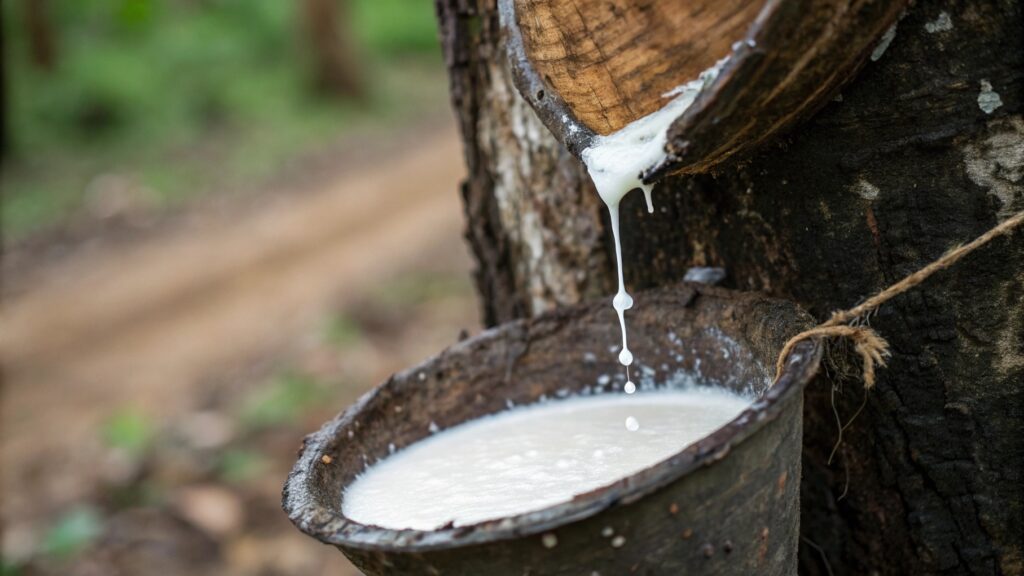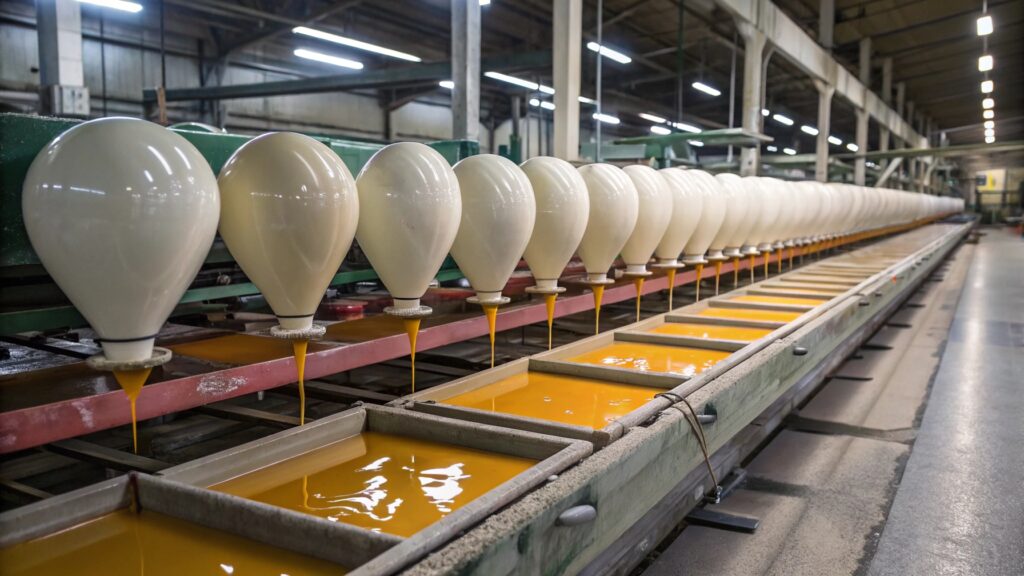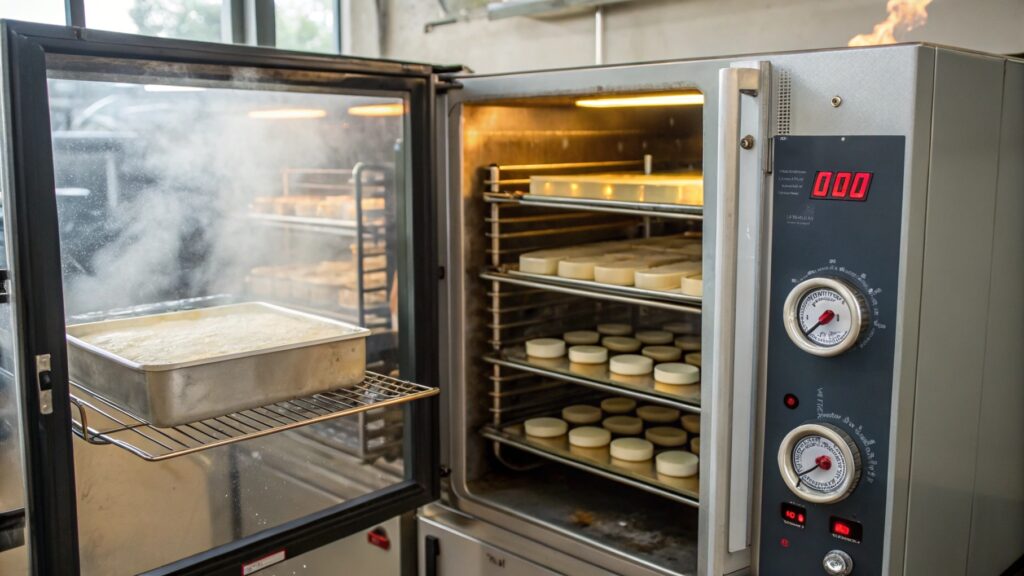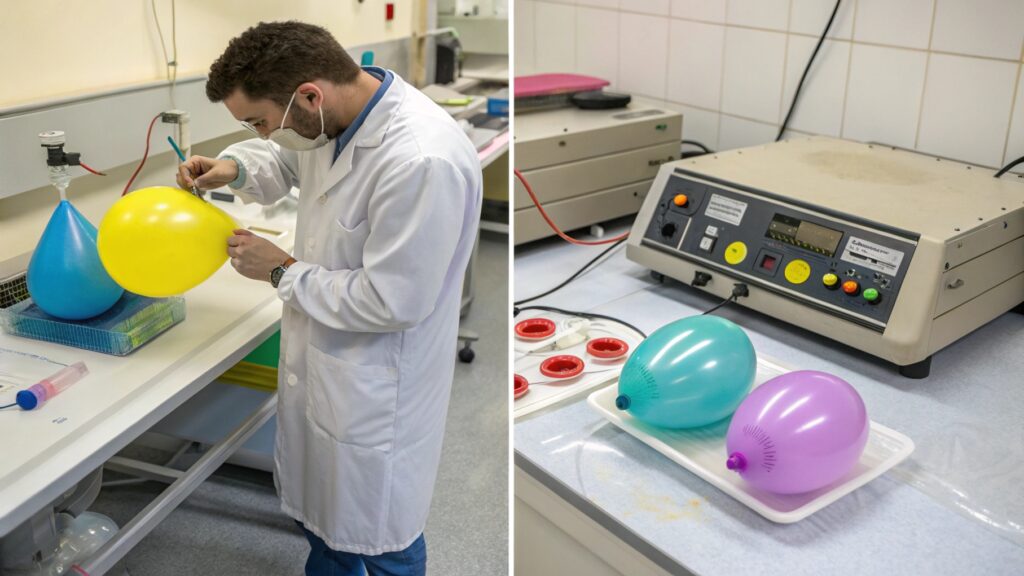Are latex balloons and condoms produced using the same manufacturing process?
Do you ever wonder what goes into making the everyday products we use? Like many, I've often paused to consider the similarities between seemingly different items. What if I told you that the vibrant balloons at your party and certain other rubber products share more than just their material? It's a question that naturally piqued my curiosity.
While latex balloons and condoms both use natural rubber latex1 and share fundamental manufacturing steps like dipping and vulcanization2, key differences exist in their specific formulations, mold designs, quality control, and regulatory requirements. Condom production demands sterile environments3 and more rigorous testing due to their medical purpose, unlike balloons.

It fascinates me to learn how things are made. I often dive deep into the production processes of items. This curiosity led me to explore the specifics of latex balloon and condom manufacturing.
How do latex balloon manufacturing4 processes compare to condom production5?
Have you ever considered how two different products, made from similar materials, can serve such distinct purposes? It's a question that often comes up when looking at manufacturing. Understanding these processes helps clarify their unique qualities.
Latex balloon manufacturing involves dipping molds into liquid latex, followed by drying and vulcanization to create inflated products. Condom production uses a similar dipping process but requires thinner latex layers, precise shape control, and rigorous testing for strength and integrity, differing significantly in final product specifications.

Raw Material Preparation: Are they the same?
When I think about the base materials, I understand that both balloons and condoms start with natural rubber latex. But from my experience, the preparation and specific additives can be quite different. This is because each product has unique requirements.
- Initial Processing: Both use liquid natural rubber latex. This latex comes from rubber trees. It is collected and then concentrated. This concentration removes water.
- Additives: Here is where they start to differ.
- Balloons: For balloons, color pigments are added. Stabilizers and coagulants are also used. These additives help with color and shape. They make the balloon durable and flexible.
- Condoms: For condoms, the additives focus on strength and flexibility. They also focus on shelf life. Other chemicals are added for these properties. These chemicals must be safe for human contact.
- Purity: Condoms require a higher purity of latex. This is very important. It reduces allergic reactions. It also ensures safety for medical use. Balloons do not have such strict purity standards. This is because their use is different.
| Material Aspect | Latex Balloons | Condoms |
|---|---|---|
| Material Base | Natural rubber latex | Natural rubber latex |
| Additives6 | Color pigments, stabilizers, coagulants | Vulcanizing agents, antioxidants, lubricants (post-production) |
| Purity Required7 | High, but less critical than condoms | Extremely high; medical-grade |
| Preparation Goal | Durability, elasticity, vibrant colors | Strength, elasticity, barrier integrity, safety |
From my perspective, the differences in additives and purity are key. They highlight the distinct purposes of each product. This initial preparation sets the stage for the rest of the manufacturing.
Are the dipping and vulcanization stages identical for latex balloons and condoms?
Have you ever considered how a liquid can turn into something solid and stretchy? This transformation is central to many products we use. It is a process that involves heat and chemistry.
While both latex balloons and condoms use dipping and vulcanization, the specific parameters differ due to product requirements. Condoms involve thinner, more precise dipping layers, and their vulcanization optimizes barrier integrity and tensile strength. Balloon vulcanization focuses on elasticity and durability for inflation, not barrier protection.

Dipping Process8: How are they different?
I see the dipping process as the heart of latex product manufacturing. It is where the shape starts to form. From my experience, while the concept is similar, the execution has critical differences.
- Molds:
- Balloons: Balloon molds vary greatly in shape and size. They can be round, long, or novelty shapes. The molds are dipped once or a few times. This creates the desired balloon thickness.
- Condoms: Condom molds are finger-shaped. They are very uniform. They are dipped multiple times. This builds up very thin layers of latex. This layering is precise. It ensures consistent thickness.
- Dipping Speed and Temperature9:
- Balloons: The dipping speed can be faster. The temperature also varies. This allows for quicker production.
- Condoms: Dipping speed is slower and more controlled. The temperature is precise. This helps prevent air bubbles. It also ensures uniform film formation.
- Coagulant Use10: Both use a coagulant. This helps the latex stick to the mold. For condoms, the coagulant layer must be consistent. This consistency is vital for product integrity. For balloons, there is less strict control over this layer.
| Dipping Aspect | Latex Balloons | Condoms |
|---|---|---|
| Mold Shape | Various: round, long, novelty, animal-shaped | Finger-shaped, highly uniform |
| Number of Dips | Usually 1-3, depending on desired thickness | Multiple, precise dips (e.g., 3-5) to build thin, uniform layer |
| Latex Thickness | Thicker, varies with balloon type | Very thin, consistent film |
| Dipping Environment | Controlled, but less stringent than condom production | Highly controlled, often requiring cleanroom conditions |
Vulcanization Process11: What makes them distinct?
For vulcanization, I recognize this as the stage where the material gains its strength. It is a curing process. My understanding is that the goals for each product guide the specific parameters.
- Heating: Both products are heated. This heating helps cross-link the rubber polymers. This process makes the latex elastic and strong. Without vulcanization, the latex would be brittle.
- Temperature and Time12:
- Balloons: The vulcanization temperature and time are set. They ensure good elasticity. They also ensure durability for inflation. They are designed for general-purpose use.
- Condoms: The vulcanization parameters are very strict. They focus on ultimate tensile strength. They also focus on elongation at break. This ensures the condom will not break during use.
- Purpose:
- Balloons: The goal is flexibility. It is also good inflation characteristics.
- Condoms: The goal is barrier integrity. It is also strength under stress. These are critical for safety.
| Vulcanization Aspect | Latex Balloons | Condoms |
|---|---|---|
| Material Curing | Cross-linking of rubber polymers | Cross-linking of rubber polymers |
| Temperature Control | Controlled for elasticity and durability | Very precise, optimized for tensile strength and barrier integrity |
| Time Duration | Sufficient for general elasticity | Longer, more controlled for high-tensile strength |
| Target Properties | Elasticity, flexibility, good inflation | High tensile strength, elongation, burst pressure, barrier integrity |
From my side, it is clear that while the underlying chemical process is the same, the fine-tuning of dipping and vulcanization is specific. It caters to the intended function of each product.
What differences exist in the quality control and testing for latex balloons versus condoms?
Have you ever considered how crucial quality checks are for products? It's not just about making something. It's about making sure it works as expected. The testing processes often reveal the true purpose of an item.
Quality control13 for latex balloons primarily focuses on visual aesthetics, inflation properties, and burst strength for consumer entertainment. In contrast, condom testing is far more stringent, including electronic integrity tests, air burst tests, and water leakage tests, ensuring reliable barrier protection for medical safety.

Testing Protocols: How detailed are they?
From my perspective, quality control is where the biggest divergence lies. It is very important to me. The level of scrutiny reflects the product's ultimate use and its safety implications.
- Regulatory Standards:
- Balloons: Adhere to toy safety standards (e.g., ASTM F963 in the US). These focus on choking hazards and flammability. They also check for lead content.
- Condoms: Subject to medical device regulations (e.g., ISO 4074 internationally, FDA in the US). These are much stricter. They demand proof of efficacy as a barrier. They also demand consistency in performance.
- Specific Tests:
- Balloons:
- Inflation Test: Check if they inflate evenly. They also check for holes.
- Burst Test: They are inflated until they burst. This measures their strength. It checks for consistency.
- Color Fastness: They check if the color bleeds.
- Visual Inspection: Checks for defects, dirt, or malformed shapes.
- Condoms:
- Electronic Integrity Test14: Each condom is tested. It passes over an electrical current. This detects tiny holes.
- Air Burst Test15: Condoms are inflated with air until they burst. This measures volume and pressure. It ensures structural integrity.
- Water Leakage Test16: They are filled with water. They are checked for leaks. This confirms barrier effectiveness.
- Tensile Properties17: Samples are pulled. This tests strength and elasticity.
- Shelf Life Testing18: They test for degradation over time.
- Biocompatibility19: They test for skin irritation or allergic reactions. This is very important.
- Balloons:
| Quality Control Aspect | Latex Balloons | Condoms |
|---|---|---|
| Primary Focus | Aesthetics, inflation, basic durability | Barrier protection, strength, safety, medical efficacy |
| Regulatory Body | Toy safety standards (e.g., ASTM, EN 71) | Medical device regulations (e.g., ISO 4074, FDA 510(k)) |
| Key Tests | Visual inspection, inflation test, burst test, color fastness | Electronic integrity, air burst, water leak, tensile, shelf life, biocompatibility |
| Testing Frequency | Batch sampling, periodic checks | Every single condom for integrity, batch sampling for physical properties |
| Defect Tolerance | Higher allowance for minor visual flaws | Near-zero tolerance for pinholes or structural defects |
| Sterility Requirement | Not required | Often required for handling/packaging, not necessarily product sterility |
Production Environment: What about cleanrooms?
From my angle, the production environment is another huge difference for balloons. I can tell you that a sterile environment is not needed, which simplifies things. For condoms, it is the opposite.
- Cleanliness Levels20:
- Balloons: Production requires a clean factory environment. But it does not need a cleanroom. Dust control is important. But strict germ-free conditions are not necessary.
- Condoms: Production takes place in a cleanroom. This is a controlled environment. Air quality is monitored. Particulate count is very low. This prevents contamination. This is vital for medical products.
- Personnel Requirements:
- Balloons: Workers wear basic factory attire.
- Condoms: Workers wear specialized suits. They wear caps, masks, and gloves. This maintains the cleanroom environment. It prevents human contamination.
- Sterilization21:
- Balloons: No sterilization is required.
- Condoms: While the manufacturing environment is clean, the product itself is not sterile. But packaging and handling prevent contamination. Some medical uses may require sterilization after packaging.
| Environment Aspect | Latex Balloons | Condoms |
|---|---|---|
| Production Facility22 | Standard clean factory environment | Dedicated cleanroom facility |
| Air Quality | Good ventilation, dust control | HEPA filtered air, monitored particulate count |
| Worker Attire | Standard factory uniform | Gowns, hairnets, masks, gloves, shoe covers |
| Contamination Risk23 | Primarily visual defects, aesthetic concerns | Critical; impacts product efficacy and user safety |
In essence, the entire quality assurance framework for condoms is exponentially more rigorous. This explains their higher cost and the trust placed in them for critical health uses.
Have you ever thought about where the raw materials for everyday items come from? It's a journey from nature to product. Understanding this journey can tell us a lot about the items themselves.
Both latex balloons and condoms source their primary raw material from natural rubber latex, typically from rubber tree plantations. Their initial preparation involves similar collection and concentration processes. However, distinct differences emerge in the post-collection treatment and the specific chemical additives based on the product's intended use and stringent quality requirements.

Sourcing of Latex: Is it identical?
From my perspective, the origin of the latex truly begins these products. I know that the basic source is the same, but the supply chain for each type of product can differ in its requirements.
- Natural Rubber Latex (NRL)24: Both products rely on NRL. This latex comes directly from rubber trees (Hevea brasiliensis). These trees are mostly grown in Southeast Asia. Countries like Thailand, Indonesia, and Malaysia are major suppliers.
- Collection Process: The sap, or latex, is harvested from the trees. This is done by making cuts in the bark. The latex then drips into collection cups. This raw liquid is then processed.
- Supplier Requirements25:
- Balloons: Suppliers need to provide consistent volume. Price is also a key factor. General quality standards apply.
- Condoms: Suppliers must meet higher purity standards. They also need to show traceability. Certifications for sustainable sourcing or ethical labor are often required. This ensures a reliable and high-grade supply.
| Sourcing Aspect | Latex Balloons | Condoms |
|---|---|---|
| Material Origin | Natural rubber latex from Hevea brasiliensis trees | Natural rubber latex from Hevea brasiliensis trees |
| Geographic Source | Primarily Southeast Asia | Primarily Southeast Asia |
| Collection Method | Tapping rubber trees | Tapping rubber trees |
| Supplier Vetting | Focus on volume, price, general quality | Focus on purity, traceability, ethical/sustainable sourcing, specific grades |
Initial Preparation of Raw Latex: Are there nuances?
When I consider the very first steps after collection, I understand that the raw latex needs immediate processing. This prevents spoilage. It also prepares it for manufacturing. My insight is that even here, the specifics begin to hint at the end product.
- Stabilization26: Fresh latex contains enzymes. These enzymes can cause coagulation. Ammonia is typically added. This stabilizes the latex. It keeps it in liquid form during transport. This step is common for both.
- Concentration27: The raw latex is about 30-40% dry rubber content. It needs to be concentrated. This usually brings it to 60% dry rubber content. This can be done by centrifugation. Centrifugation spins the latex. It separates the rubber particles from the water. This is also common for both.
- Pre-Vulcanization28 (Optional): Some manufacturers pre-vulcanize the latex. This is partial curing. It is done before dipping. This can sometimes be used for balloons. It is used to achieve certain properties. It is generally not used for condoms. Condoms need the full vulcanization step after molding for precise control.
- Filter and Storage:
- Balloons: The concentrated latex is filtered. This removes impurities. It is stored in large tanks. Cleanliness is important.
- Condoms: The concentrated latex undergoes more rigorous filtration. It must remove even finer particles. It is stored in sterile tanks. The storage conditions are carefully controlled. This prevents microbial growth. This is a critical step for hygiene.
| Preparation Aspect | Latex Balloons | Condoms |
|---|---|---|
| Stabilization | Common (e.g., ammonia) | Common (e.g., ammonia), stricter control |
| Concentration Method | Centrifugation (common) | Centrifugation (common), may have additional purification steps |
| Dry Rubber Content Target29 | ~60% | ~60% |
| Filtration Level30 | Standard for removing visible impurities | Micro-filtration for even microscopic particles |
| Storage Conditions | Clean, temperature-controlled tanks | Sterile, temperature-controlled, often agitated tanks |
From my experience, while the starting point is shared, the journey quickly branches into specialized paths. This is based on the precision and safety demands of the final product.
Conclusion
Both latex balloons and condoms utilize similar raw materials and fundamental manufacturing steps. Yet, key differences in additives, environmental controls, and especially extensive quality testing distinguish their production, driven by their critical and distinct end uses.
-
Exploring this link will deepen your understanding of natural rubber latex and its diverse applications beyond balloons and condoms. ↩
-
Learn about vulcanization to appreciate its critical role in enhancing the durability and performance of rubber products. ↩
-
Exploring this resource will provide insights into the critical practices that ensure product safety and quality in sterile environments. ↩
-
Explore this link to understand the intricate steps of latex balloon manufacturing, enhancing your knowledge of production processes. ↩
-
Discover the unique aspects of condom production, including quality control and material specifications, to appreciate its complexity. ↩
-
Learn about the different additives used in latex products and how they affect performance and safety. ↩
-
Understand the significance of high purity in latex condoms for safety and effectiveness, especially in medical applications. ↩
-
Understanding the dipping process is essential for grasping how latex products are formed and their quality. ↩
-
This resource will explain how these factors affect the quality and efficiency of latex products. ↩
-
Learning about coagulants will enhance your understanding of how latex adheres to molds and affects product quality. ↩
-
This link will clarify how vulcanization strengthens latex products and its importance in production. ↩
-
Understanding these parameters is crucial for ensuring the durability and performance of latex items. ↩
-
This resource will provide a detailed comparison of quality control processes for these two products. ↩
-
Learn about the electronic integrity test to understand how it ensures the safety and reliability of condoms. ↩
-
Explore this link to understand the critical Air Burst Test, ensuring condom safety and effectiveness. ↩
-
Understanding the Water Leakage Test is crucial for ensuring condom safety and effectiveness, making it a vital resource for consumers. ↩
-
Understanding tensile properties is crucial for evaluating material strength and durability, especially in safety-critical applications. ↩
-
Understanding shelf life testing is crucial for ensuring product safety and efficacy, especially for medical devices like condoms. ↩
-
Explore biocompatibility testing to grasp its significance in preventing allergic reactions and ensuring user safety. ↩
-
Understanding cleanliness levels helps in grasping the production standards for these products, ensuring quality and safety. ↩
-
Exploring sterilization processes reveals the safety measures in place for medical products, crucial for consumer trust. ↩
-
Learning about production facilities provides insight into manufacturing standards and their impact on product quality. ↩
-
Understanding contamination risks is vital for consumers to make informed choices about product safety and efficacy. ↩
-
Explore this link to understand the properties and applications of NRL, which is crucial for various products including balloons and condoms. ↩
-
This resource will provide insights into the specific standards and certifications needed for latex suppliers, ensuring quality and sustainability. ↩
-
Understanding stabilization helps ensure the quality and longevity of latex products during transport and storage. ↩
-
Learning about concentration methods can enhance knowledge of rubber content and its impact on product quality. ↩
-
Exploring pre-vulcanization reveals how manufacturers tailor properties for specific applications like balloons. ↩
-
Understanding the ideal dry rubber content is crucial for ensuring quality and performance in latex products like balloons and condoms. ↩
-
Understanding filtration levels is crucial for ensuring product safety and hygiene, especially for sensitive items like condoms. ↩
